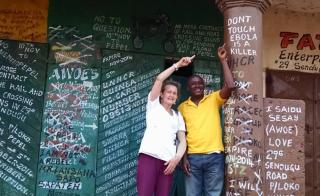Advertisement
As a lifelong Unitarian Universalist, Dr. Patricia Ruze has dedicated her medical career to those most in need. She lived in Micronesia and spent seven years in Kenya, where she was a regional physician for Peace Corps Volunteers. She’s also a founding director of At Home and Afar, which provides modern health care for those who can least afford it.
“I definitely feel that growing up as a UU has had a tremendous impact on life’s choices and my commitment to humanitarian service and the international focus of my life,” said Ruze, a member of Harvard UU Church in Harvard, Massachusetts, along with her husband John Chapman and teenage children, Paul and Nicky.
As the medical director for two Massachusetts prisons, where Ruze is the only physician for 1,500 inmates, she said, “I love the work, as this is a very medically needy and underserved population.”
When the deadly Ebola virus began ravaging West Africa in 2014, Ruze was determined to help. In January, she traveled to Sierra Leone for six weeks to care for Ebola patients, and then sat in quarantine for another three weeks before she could return home. “Being able to serve as a volunteer physician in the global Ebola efforts is a privilege for me,” said Ruze, a Fellow of the American College of Physicians, a mark of distinction for specialists in internal medicine.
The following are excerpts from a journal that Ruze, who worked in Sierra Leone with a team of doctors and nurses through Boston-based Partners in Health, kept during her experience:
Week one
“My colleagues and I have been a week in Sierra Leone. We’ve attended five full-day sessions presented by the World Health Organization to help us understand Ebola, how it infects, sickens, kills, and importantly, infection control procedures such as the use of the PPE (Personal Protection Equipment, i.e., those alien space suits) … As of this writing, there have been 8,033 confirmed cases of Ebola in Sierra Leone, with 2,874 deaths … [with] a 100-fold higher death rate among health care workers than non-health-care workers … We spent a significant amount of time learning ‘donning’ and ‘doffing.’ Donning describes the precise process of putting on clunky rubber boots, hair bonnet, Tyvek suit, mask, goggles or face shield, hood, two sets of gloves and apron … The thirty-minute doffing process involves a specific hand-washing regimen eleven times during the procedure … ”
The hot zone
“Today is my first day in the hot zone … We also call the most infectious areas in the Ebola Treatment Unit the Red Zone … Full PPE is always worn in the Red Zone … As we enter the unit the sweat is already pouring into my gloves and my face shield is fogging, my mask is soaking up sweat … My buddy and I are able to see only four patients during this trip inside the Red Zone. The first patient is an 11-month-old chubby baby boy with huge brown eyes and long lashes. We had made him a ‘crib’ by stacking metal bed frames on their sides in a square. He stood clinging to the railing and crying. He and his mother had been together in the suspect ward for several days until his mother’s Ebola test came back positive. Although she was still nursing the child she had to be moved to the confirmed ward. The baby’s test was negative so he was being kept alone in this unit. We held the baby the best we could with our awkward and alien costumes. We changed his diaper and tried to get him to eat and drink. When we left ten minutes later, he was standing up holding the rail of his crib sobbing and sobbing, very alone … In medicine, doctors are regularly confronted with the inability to provide a cure. At times we are unsuccessful in alleviating physical and mental discomfort … Our physical connection to our patients is limited dramatically by PPE. This is a new level of helplessness.”
The gift
“Mariatu is a 16-year-old woman who miscarried late in her first pregnancy … Dr. Ashley ordered two units of whole blood for Mariatu … I am gradually learning that nursing care, pharmacy, and laboratory in our ‘free’ government hospital involve multiple complex financial transactions … Official arrangements were made for the payment of [local currency] directly to the hospital to facilitate transfusion for Mariatu. Unfortunately this doesn’t seem to translate into cash for the blood sellers … Coincidentally, Dr. Ashley and I both have O-negative blood types. We are universal donors … The process of giving up two units of blood was easy and one of the more rewarding experiences I have had in terms of directly helping a patient … [But] what about the next patient who needs blood? What kind of precedent had we set at the hospital? … While my gift of blood may have been the moral thing to do, it may not have been the right thing to do. It certainly was not the simple gift, given from my heart, which I had intended.”
